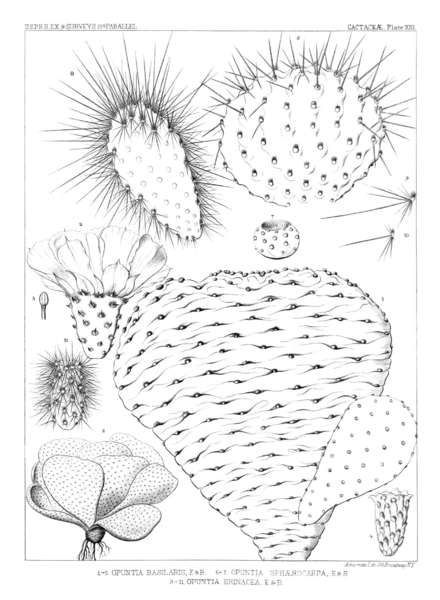User:Shazzy303/sandbox
 | This is a user sandbox of Shazzy303. You can use it for testing or practicing edits. This is not the sandbox where you should draft your assigned article for a dashboard.wikiedu.org course. To find the right sandbox for your assignment, visit your Dashboard course page and follow the Sandbox Draft link for your assigned article in the My Articles section. |
First assignment to edit an article.[edit]
California newts reside in the coastal counties of California and in the southern Sierra Nevada and occupy a diverse array of habitats found near the small ponds and creeks where they breed, including woodlands and chaparral[1][2]
Information regarding main article I worked on.[edit]
Alright, it is decided that i'm going to update and edit the Opuntia basilaris article for my project. I'll be adding the following sections:
Lead Section - (Genus Species, growth form?)- did not end up updating.
Description - Describe leaves flowers fruiting bodies- description section seems pretty solid.
- Taxonomy - When was it discovered and described? Etymology, Major Synonyms, changes in classifications.
- Distribution and Habitat - Where does it grow? Geography, elevation, climate, soil type, desnity, clumping?
Ecology subsection - Interactions w the environment (pets pollinators disease) or conservation concerns
- Uses (Culture) - Hows it used by humans or cultivation details.
Bibliography sources/descriptions
- Drought Adaptations - Stan R. Szarek et al., “Drought Adaptation in Opuntia Basilaris. Significance of Recycling Carbon through Crassulacean Acid Metabolism,” Plant Physiology 52, no. 6 (1973): 539–41.
- Rainfall Response - Stan R. Szarek and Irwin P. Ting, “Physiological Responses to Rainfall in Opuntia Basilaris (Cactaceae),” American Journal of Botany 62, no. 6 (1975): 602–9, https://doi.org/10.2307/2441938.
- Heat Adaptation - S. L. Gulmon and A. J. Bloom, “C₃ Photosynthesis and High Temperature Acclimation of CAM in Opuntia Basilaris Engelm. and Bigel,” Oecologia 38, no. 2 (1979): 217–22.
- Pollination - Verne Grant and Karen A. Grant, “Pollination of Opunta Basilaris and O. Littoralis,” Plant Systematics and Evolution 132, no. 4 (1979): 321–25.
- more drought adaptation response to stress water loss etc. - Wayne Barcikowski and Park S. Nobel, “Water Relations of Cacti During Desiccation: Distribution of Water in Tissues,” Botanical Gazette 145, no. 1 (1984): 110–15.
- effect of spines on light? - “The Effect of Cactus Spines on Light Interception and Photosystem II for Three Sympatric Species of Opuntia from the Mojave Desert - Loik - 2008 - Physiologia Plantarum - Wiley Online Library,” accessed November 2, 2022, https://onlinelibrary.wiley.com/doi/full/10.1111/j.1399-3054.2008.01110.x.
- Taxonomy - Lyman Benson, “Taxonomic Studies,” American Journal of Botany 28, no. 5 (1941): 358–64, https://doi.org/10.2307/2436811.
- more on light - Park S. Nobel, “Interception of Photosynthetically Active Radiation by Cacti of Different Morphology,” Oecologia 45, no. 2 (1980): 160–66.
- Uses! - Jean Feugang et al., “Nutritional and Medicinal Use of Cactus Pear (Opuntia Spp.) Cladodes and Fruits,” Frontiers in Bioscience : A Journal and Virtual Library 11 (February 1, 2006): 2574–89, https://doi.org/10.2741/1992.
- more cactus uses - Daniel E. Moerman - Native American Ethnobotany-Timber Press, Incorporated (1998)
- on medicinal specifically analgesic properties of opuntia genus - Reza Shirazinia et al., “Opuntia Dillenii: A Forgotten Plant with Promising Pharmacological Properties,” Journal of Pharmacopuncture 22, no. 1 (March 2019): 16–27, https://doi.org/10.3831/KPI.2019.22.002.
- more cactus uses - Ken Hedges, Santa Ysabel Ethnobotany, Ethnic Technology Notes ; No. 20 (San Diego, Calif: San Diego Museum of Man, 1986).
SECTION FOR PREPARING EDITS BEFORE PUBLISHING
Taxonomy[edit]

One of the first known descriptions of opuntia basilaris come from the reports of the explorations and surveys for a railroad route from the Mississippi River to the Pacific Ocean. This expedition followed the 35th parallel through New Mexico, Arizona, and California. In the 4th volume of this report, The Botany of the Expedition, by George Engelmann and John M. Bigelow, Opuntia basilaris is described as a stout fan shaped opuntia resembling an open cabbage head, with accompanying illustrations.[3]
Distribution and Habitat[edit]
This species of cactus is found in the Southwest US regions including California, Nevada, Arizona, Utah, and Northwestern Sonora, Mexico. This plant can be found in chaparral, desert, and grassland. This cactus grows in well draining mediums composed of sand, gravel, cobble, or even on boulders.[4][5]
Uses[edit]
The Diegueño would consume it as a dried fruit after removing the thorns.[6]
The Shoshone Native American Tribe took advantage of the analgesic properties of this cactus by creating a poultice from the inner mucilage to treat minor cuts. [7][8]
- ^ "California Newt (Taricha torosa) aCFNEx_CONUS_2001v1 Habitat Map - ScienceBase-Catalog". www.sciencebase.gov. Retrieved 2022-11-02.
- ^ Marchetti, Michael P.; Hayes, Abigail (2020-06-20). "Life History Variation in Two Populations of California Newt, Taricha torosa". Western North American Naturalist. 80 (2): 165. doi:10.3398/064.080.0204. ISSN 1527-0904.
- ^ Engelmann, George; Bigelow, John M. (1856). Pacific Railroad Survey Reports "The Botany of The Expedition". Vol. 4. Washington DC: US Government Printing Office. pp. 43–44.
- ^ Williams, Daniel; Cypher, Ellen; Kelly, Patrick; Miller, Karen; Norvell, Nancy; Phillips, Scott; Johnson, Cheryl; Colliver, Gary (1998). Recovery Plan for Upland Species of the San Joaquin Valley, California. Portland, Oregon: US Fish and Wildlife Service. pp. 49–50.
- ^ Anderson, Edward F. (2001). The Cactus Family. Portland, Oregon: Timber Press Inc. p. 498. ISBN 0-88192-498-9.
- ^ Ken., Hedges, (1986). Santa Ysabel ethnobotany. San Diego Museum of Man. ISBN 0-937808-42-3. OCLC 1170591869.
{{cite book}}: CS1 maint: extra punctuation (link) CS1 maint: multiple names: authors list (link) - ^ Moerman, Daniel E. (1998). Native American Ethnobotany. Timber Press, Incorporated. p. 365. ISBN 0-88192-453-9.
- ^ Shirazinia, Reza; Rahimi, Vafa Baradaran; Kehkhaie, Ashrafali Rezaie; Sahebkar, Amirhossein; Rakhshandeh, Hassan; Askari, Vahid Reza (2019-03-31). "Opuntia dillenii : A Forgotten Plant with Promising Pharmacological Properties". Journal of Pharmacopuncture. 22 (1): 16–27. doi:10.3831/KPI.2019.22.002. ISSN 2093-6966.
